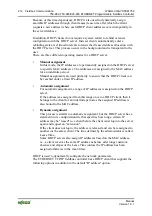
208 Fieldbus Communication
WAGO-I/O-SYSTEM 750
750-880, 750-880/025-000 ETHERNET Programmable Fieldbus Controller
Manual
Version 1.0.1
12.1.1.2 TCP (Transmission Control Protocol)
As the layer above the Internet protocol, TCP (Transmission Control Protocol)
guarantees the secure transport of data through the network.
TCP enables two subscribers to establish a connection for the duration of the data
transmission. Communication takes place in full-duplex mode (i.e., transmission
between two subscribers in both directions simultaneously).
TCP provides the transmitted message with a 16-bit checksum and each data
packet with a sequence number.
The receiver checks that the packet has been correctly received on the basis of the
checksum and then sets off the sequence number. The result is known as the
acknowledgement number and is returned with the next self-sent packet as an
acknowledgement.
This ensures that the lost TCP packets are detected and resent, if necessary, in the
correct sequence.
TCP Data Packet
The packet header of a TCP data packet is comprised of at least 20 bytes and
contains, among others, the application port number of the transmitter and the
receiver, the sequence number and the acknowledgement number.
The resulting TCP packet is used in the data unit area of an IP packet to create a
TCP/IP packet.
TCP Port Numbers
TCP can, in addition to the IP address (network and subscriber address), respond
to a specific application (service) on the addressed subscriber. For this the
applications located on a subscriber, such as a web server, FTP server and others
are addressed via different port numbers. Well-known applications are assigned
fixed ports to which each application can refer when a connection is built up
(Examples: Telnet Port number: 23, http Port number: 80).
A complete list of "standardized services" is contained in the RFC 1700 (1994)
specifications.
Pos: 94 /Alle Serien (Allgemeine Module)/Feldbuskommunikation/ETHERNET/UDP (User Datagram Protocol) @ 4\mod_1237211297860_21.doc @ 28505 @ 4 @ 1
12.1.1.3 UDP (User Datagram Protocol)
The UDP protocol, like the TCP protocol, is responsible for the transport of data.
Unlike the TCP protocol, UDP is not connection-orientated; meaning that there
are no control mechanisms for the data exchange between transmitter and
receiver. The advantage of this protocol is the efficiency of the transmitted data
and the resulting higher processing speed.
Pos: 95 /Alle Serien (Allgemeine Module)/Feldbuskommunikation/ETHERNET/Konfigurations- und Diagnoseprotokolle - Überschrift 3 @ 4\mod_1237211597686_21.doc @ 28511 @ 3 @ 1






























